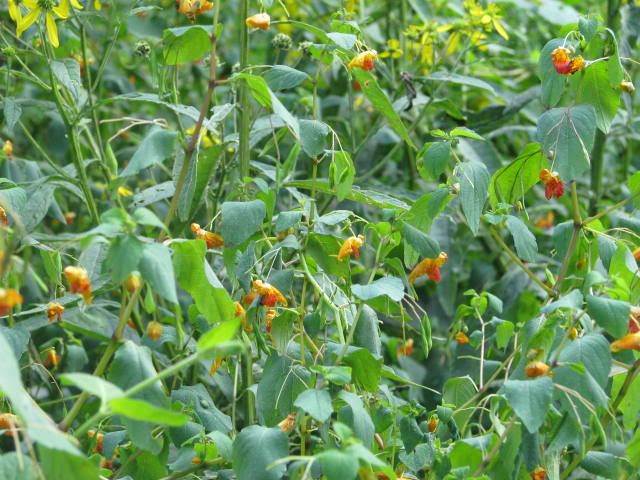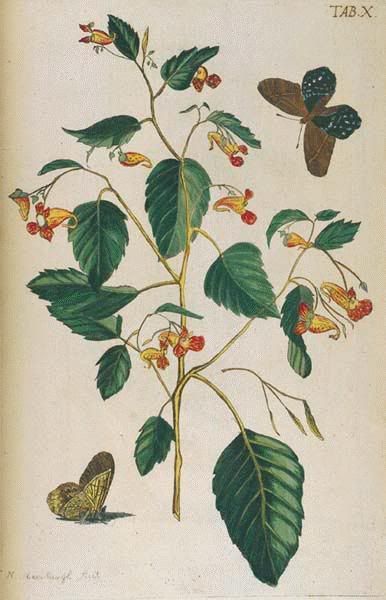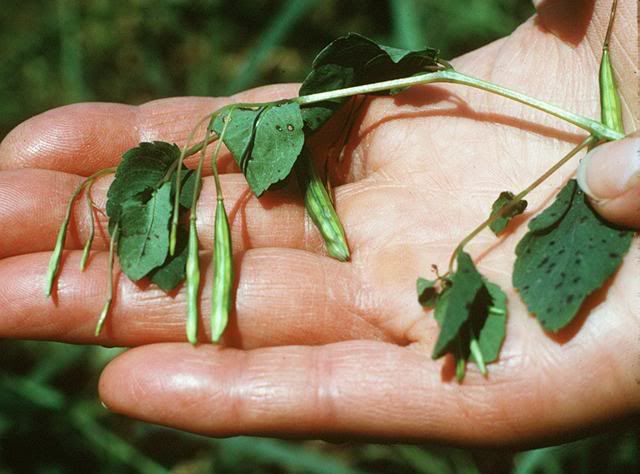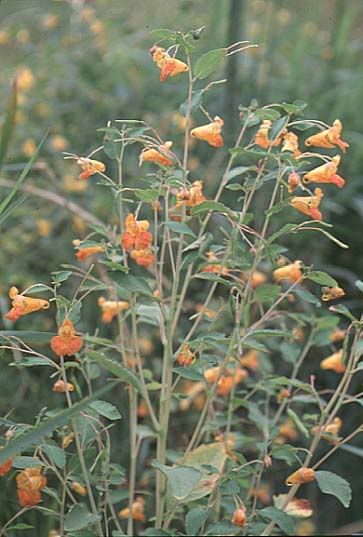- Back to Home »
- food , herbs , jewelweed , medicinal , medicine , plants , wildedibles »
- Jewelweed

Although this isn't one of my favorite wild foods, It's one of our most important herbs. I call jewelweed the foragers American Express, because I never leave home without it.
Jewelweed Sprout
Note the succulent, translucent, un branched stalk and the pair of roundish, notched leaves, very different from subsequent leaves.
It's common, widespread, easy to recognize, and invaluable to anyone venturing out-of-doors, because it's a virtual panacea for skin irritation.
Jewelweed
The paired, elliptical, coarsely toothed (serrated) leaves of older shoots are typical of the plant.
This herbaceous native plant has distinctive succulent, translucent, hollow, stem, powdered with a pale blue-green, waxy bloom and partitioned by nodes, making the plant easy to identify. Jewelweed grows up to five feet tall, branching toward the top, and toughening with age. There ís a clear, watery liquid inside, especially in the nodes.
The delicate, long-oval, long-stalked, leaves are 1/4 to 1/2" long, with a few rounded teeth. The upper leaves are alternate, the lower ones opposite. They're water-repellent, so they look like they're covered with tiny jewels (raindrops) after it rains, accounting for the name jewelweed.
Either like electrical charges, which repel each other, line up on the surface of the leaf and the surface of the water drop, or a waxy coating on the leaf repels the water, forcing it into a spherical shape.
If you submerge the leaves in water, their undersides will turn silvery, delighting children of all ages.
The trumpet-shaped flowers, which bloom from early summer to fall, are under 1 inch long, with three petals, one which curls, to form a long slipper- or sack-shaped spur.
The red spots on the orange petals attract pollinators.
Spotted touch-me-not has orange-yellow flowers spotted with red, yellow or white. They're usually in pairs, so the scientific name is Impatiens biflora.
Jewelweed Drawing
The trumpet-shaped flower has a long spur at the end. Pollinators with long tongues, such as butterflies, moths, and hummingbirds, can reach the nectar at the end. Other insects simply chew through the flower's base.
Pale touch-me-not (Impatiens pallida) has yellow flowers with reddish spots. Pallida means pallid.
The stamens at the top of the inside of the flower dust pollinators with pollen as they go after the nectar deep inside the flower.
In late summer and fall, you can surround the ripe seedpods with your hand, and grab them tightly.
Because of the long flowering season, flowers and mature seed pods often grow side by side.
The seeds will pop into your hand, and you can eat them, discarding the coiled "springs." They're very tasty—walnut flavored, but too small for more than a trail nibble. Children, who seek out fun over efficiency, love learning to catch and eat jewelweed seeds.
Caution: Don't grab the seed pods loosely, or the seeds will pop away—especially important if you're Catholic—you're not supposed to spill your seeds!
Jewelweed Seeds and Open Pod
Mature seeds are flattened-ovate, green to blackish, and with a ridge running along the length on both sides.
Jewelweed contains two methoxy-1, four napthoquinine, an anti-inflammatory and fungicide that's the active ingredient of
Preparation H.
Instructions for Use:
Apply where "The sun don't shine!"
Mosquito at Work ?If you break jewelweed's stem and repeatedly apply the juice to a fresh mosquito bite for 15 to 20 minutes, the itching stops and the bite doesn't swell.
For older bites, it works only temporarily.
Man Getting Stung ?Jewelweed's juice also relieves bee and wasp stings, although it doesn't always cure them completely.
Athlete's Foot?It's also good to for warts, bruises, and fungal skin infections such as athlete's foot and ringworm.
It's is also helpful for nettle stings, minor burns, cuts, eczema, acne, sores, and any skin irritations.
If you accidentally touch poison ivy and apply jewel weed juice to the affected area before the rash appears, you probably won't get the rash. One of my best strawberry patches is also infested with poison ivy. You can't avoid touching it as you collect the irresistible fruit. I have everyone apply jewel weed to all exposed areas when we leave, and nobody ever gets a rash.
The Indians treat already-developed poison ivy rash by rubbing jewel weed ís broken stem on the rash until it draws some blood. The rash then dries out, a scab forms, and healing occurs.
There are many ways to capture jewel weed's medicinal properties: The fresh plant lasts a week in a sealed container in the refrigerator. 1960s foraging guru and author Ewell Gibbons reported the jewel weed tincture he extracted in alcohol went moldy, but I've soaked fresh Jewel weed in commercial witch hazel extract for a few weeks, and the extract of the two herbs works well and doesn't perish.
You can also make Jewel weed ointment by simmering a small amount of Jewel weed in light vegetable oil (any vegetable oil except olive oil, which burns) 10-15 minutes. Use only a small handful of Jewel weed stems per quart of oil, or bubbles of Jewel weed juice will form in the ointment and go moldy. Strain out the herb, add a handful of beeswax to thicken it, and heat until melted. Take out a spoonful and let it cool to test the thickness, and add more oil or beeswax as needed. Add the contents of one oil-soluble vitamin E capsule, a natural preservative, and let it cool. Refrigerated, it lasts for months.










